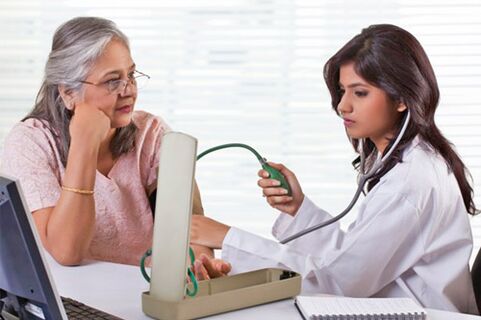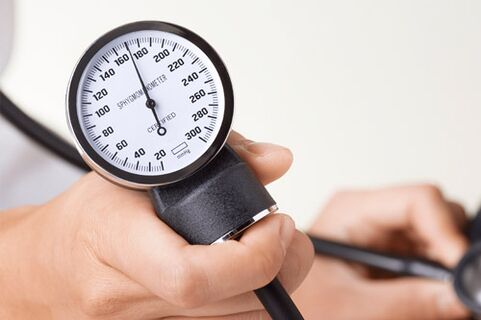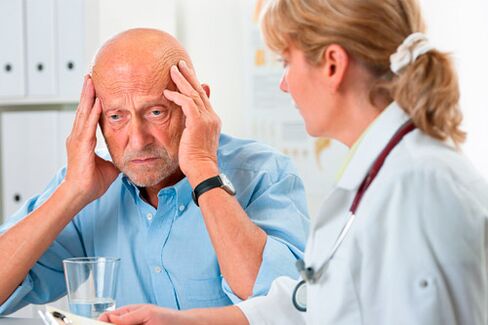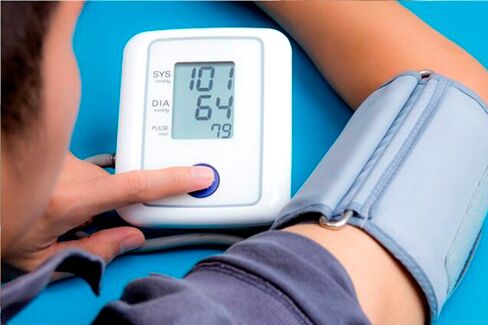Traits related to the age of different periods of a person's life, external and internal causes, changes in hormonal levels, bad habits, as well as psycho-emotional factors can affect changes in blood pressure and lead toits growth. Not always on time people go to the doctor, so hypertension takes a permanent form. The article will tell about the symptoms of hypertension as well as its changes with hypotension.
The first manifestations

High blood pressure is characterized by morphological changes in the blood vessels that affect a person’s overall well-being. To understand if a person has hypertension and what symptoms are characteristic of this pathology, you need to know the simplest methods of self-diagnosis that will help you respond correctly to a jump in indicators and prevent complications.
Hypertension is one of the most common diseases. Hypertension occurs in every third person and is characterized by high mortality in severe stages. Only complex treatment that combines medication and maintaining a healthy lifestyle can be successful.
Hypertension is characterized by a gradual, long, slow course and is initially characterized by the absence of severe symptoms. In high blood pressure, the presence of the disease can be indicated by symptoms that appear periodically, which include:
- pain in the occipital or temporal region;
- dizziness;
- hearing loss, tinnitus;
- blurred vision;
- tachycardia and chest pain;
- nausea and mouth reflex;
- feeling of shortness of breath;
- anxiety;
- nervousness;
- sweating or chills;
- recurrent nosebleeds.
The presence in a person of at least one of the above symptoms of hypertension, which may be the first, is a reason to visit a family doctor or therapist for diagnostic and preventive purposes, as the disease in an advanced state anduntreated can lead to such frightening complications as myocardial infarction and ischemic strokes.
Characteristics of symptoms
Hypertension always goes away with a headache in the back of the head or in the temples, which, at the beginning of the development of pathology, is well stopped by analgesic drugs. Its appearance is accompanied by a change in the lumen of the cerebral vessels in the direction of narrowing. People who experience headaches with high blood pressure describe it as dull or as cramps in the back of the head and sharp, stinging, throbbing in the temporal region.
Tinnitus and hearing damage in hypertension can be caused by a malfunction of the vessels of the hearing aid.
Important! The sudden onset of headache is a direct indicator of pressure measurement.
Deterioration of vision in hypertension in the form of double, inflammatory (flies) spots in front of the eyes is accompanied by a lack of blood supply to the retina and impaired functioning of the optic nerves.
Nausea and dizziness occur as a reaction to the onset of headache and dizziness, and the appearance of frequent heartbeats and pain behind the sternum is caused by a disorder in the work of the pulmonary circulation vessels. The feeling of shortness of breath (shortness of breath) characterizes high blood pressure, and most often appears in obese patients at any age.
Frequent onset of symptoms of high blood pressure can cause a hypertensive condition. And then, facial skin hyperemia, anxiety, heart pain will join the above signs of pathology. This condition will not go away on its own and will require urgent therapy.
Important! Periodic onset of symptoms of high blood pressure will prompt the patient to consult a physician and begin treatment. The asymptomatic course of the disease robs a person of precious time.
Tonometer indicators
To understand if there is an increase in pressure, it is necessary to periodically measure the indicators with a tonometer in different conditions (well-being, poor), and also to know their rates.
Standard values are considered to be 120/80 mm Hg. Art. A range of 10 units from these digits is not a deviation. Signs of an increase greater than 140/90 mm Hg. Art. , in combination with headache, feeling of nausea, heart pain are considered as symptoms of hypertension.
Important! Pressure on a person is always individual, it depends on the body and external causes. "Working" tone - these are the blood pressure numbers at which the patient feels well. Patients with hypertension know their normal values and control them by taking timely antihypertensive drugs selected by the attending physician.
Characteristics of pathology degrees
Signs of high blood pressure depend directly on the degree of elevation of the indicators, of which are 3 in hypertension, they can be presented in the form of tables:
| Degrees of hypertension | Systolic index (mm Hg) | Diastolic numbers (mm Hg) | The main symptoms of hypertension |
|---|---|---|---|
| 1 degree | 140-160 | 90-100 | They pass without a clear clinic, are characterized by periodic elevations, normalize quickly. Rarely observed dizziness, insomnia, aggravation in the head, with localization in the back of the head. |
| 2 degrees | 160-180 | 100-110 | Pain in the occipital or temporal region is pronounced, accompanied by nausea, dizziness, weakness, insomnia. |
| 3 degrees | up to 182 and above | over 110 | Unbearable headache (especially in the morning), nausea, vomiting, tinnitus, vision problems, shortness of breath, sweating, tachycardia, swelling of the lower extremities, thirst, urinary disorders. |

The clinic of hypertension in the early stages can be easy. A person for a long time may not even be aware of the increased pressure and processes that take place on the vessel. The early and first signs of hypertension are irritability for no apparent reason and increased fatigue.
Symptoms of high blood pressure in hypertension 2 and 3 degrees with systolic readings over 160 mm. lead to a hypertensive crisis, which is characterized by a pronounced headache of various natures, a feeling of nausea, vomiting, blurred vision (fog, shroud) or burning of small spots, as well as: tremors in the limbs; rapid pulse, shortness of breath, heart pain, arrhythmia, loss of consciousness.
What is hypertension - all patients with hypertension know. It is helpful to know how you can help yourself or a loved one before an ambulance arrives when an emergency first occurs:
- Place 1 tablet of validol or nitroglycerin under the tongue.
- Arrange air entry, unbutton tight clothing, and give the patient a raised position on the bed (stand on the pillow).
- Put the mustard plaster on the calf muscles.
- Give within 30 drops (1 tablespoon) of an alcoholic solution of valerian, valerian.
- Take an analgesic for the headache and lubricate the whiskey, forehead, neck and behind the ears area with menthol oil.
- You can wash your feet in hot water for 15 minutes.
In addition, doctors recommend doing a simple exercise to restore breathing. To do this, it is recommended to take a deep breath, hold your breath and then exhale very slowly. This should be done 3 to 5 times. The body position in this case should be supine.
Important! With premature help for a patient with hypertensive crisis, he may develop a stroke or myocardial infarction. Since grades 2 and 3 cannot be cured, the patient must keep the pressure increase under constant control.
Age characteristics
An increase in blood pressure in people over 50 is often associated with initial problems in the functioning of the heart and blood vessels, atherosclerosis, anemia, hyperthyroidism and impaired kidney function. There may be shortness of breath, pronounced swelling in the legs, cardiac arrhythmia. Compared to men, women get sick more often.
The symptoms of high blood pressure are always due to age-related changes in the vessels, causing a loss of their elasticity. In addition to the typical clinical features of high blood pressure, it is possible to add intermittent claudication, frequent fainting, dizziness when changing body position, noise in the head, and a symptom of oppressive pain behind the sternum. There are also general illnesses, decreased performance and weakness.
Since the increase in indicators can occur in people of different ages, the symptoms of hypertension in adolescents can appear from the age of 12 (during puberty) and continue until 17. This is due to the restructuring of the body and changes in metabolismhormonal. . Characteristic signs that a teenager has an increase in blood pressure are increased sweating, attacks of strong heartbeat, the presence of tinnitus, dizziness, headache at any time of the day, insomnia, hot flashes on the skin of the face, disturbance in the epigastric region. .
Important! To ensure that in this particular case a possible vascular pathology occurs, it is necessary to measure the pressure in a person several times in a row, preferably every 15 minutes. These indications should be recorded and be sure to report them to your doctor to prescribe appropriate treatment. Which medication to take - the doctor will decide.

If you find some symptoms associated with an increase in blood pressure, you should consult a doctor, be examined and identify the true cause of such pathology: neoplasms, kidney disease, endocrine, vascular. The therapist, neuropathologist and family doctor will prescribe the appropriate treatment based on diagnostic data, functional characteristics of the organism, age group, concomitant diseases and propensity to allergies.
With hypertension, adrenoblockers, diuretics, ACE inhibitors, slow calcium channel blockers are prescribed.
Apply physiotherapy - electrogum; magnetotherapy; UHF therapy; infrared laser therapy as well as traditional medicine. Patients with hypertension are advised to follow a diet and consume plenty of fruits and vegetables.
Important! Preventive measures to prevent vascular pathology and the development of hypertension include timely visits to medical examinations, normalization of work and rest, moderation in diet, fight against excess weight, prevention of stressful situations, use of sufficient amounts of water, vegetables. , fruits, as well as the elimination of nicotine and alcohol addiction (if any).
Differences between high and low pressure
Along with the signs of hypertension, in which the rate may increase, there are manifestations of low blood pressure, called hypotension.
Periodic pressure drop is characterized by indicators below 101/66 mm Hg. Art. It all depends on the age group, so the numbers may vary.
Despite the fact that the presence of an unbearable paroxysmal headache occurs with both hypotension and hypertension, with a decrease in pressure, the following symptoms will be present that distinguish high pressure from low:

- Poor health and weakness. In the morning the patient feels weakness and regret.
- Cold extremities. The hands and feet are constantly cold.
- Noise in the ear (periodic presence).
- Unpleasant sensation in the heart region, tachycardia. Every patient has their own feelings.
- Frequent dizziness and darkening (sometimes double vision) in the eyes. Such symptoms are characteristic not only in the morning but also during the day.
- Drowsiness during the day, sleep disturbance at night. During the day, patients feel the need to sleep all the time. The peak of the activity starts in the evening. The night passes without rest, sleep is shallow.
- Digestive problems. Patients with hypotension often have gastritis, liver problems, constipation, indigestion and dysbacteriosis.
The above characteristic symptoms are more common in young people, most of whom are women. The reason for lowering blood pressure is stress, lack of sleep, poor lifestyle, lack of vitamins, use of strict diets, hormonal disorders, severe physical and mental stress, the presence of some somatic diseases (endocrine, osteochondrosis of the neckof the uterus, liver, kidneys. , VVD, sedentary lifestyle). Prolonged depression can be the leading cause of low blood pressure.
The first "bells" to start the development of hypotension occur when in the morning the person gets out of bed heavily, feels overwhelmed, irritated and does not get enough sleep. After a while (everyone is just individual), a headache appears, which may not go away until lunch.
Here, common symptoms with hypertension are the appearance of nausea, vomiting, meteorological dependence, and fainting, a long asymptomatic course. You can increase low blood pressure by taking special medications, diet therapy, herbal remedies and maintaining a healthy lifestyle.
therapy
Medicines that increase blood pressure include tinctures of Eleutherococcus or Ginseng, special medicines. Caffeine has the same effect.
Herbal medicine involves taking decoctions and infusions of herbs from plants such as St. John's wort, lemon grass, ginseng, immortality, tartar, ginger.
For patients with hypotension, it is acceptable to take small doses of alcohol. A glass of red wine or 25 g of cognac for a week will benefit the body: it will dilate blood vessels and improve blood circulation. A cup of coffee in the morning will bring a good mood.
Patients with hypotension should get enough sleep to feel alert (more than 8 hours a day), get enough exercise, eat a balanced diet and also engage in moderate sports (morning exercises, swimming, gymnastics, yoga, outdoor games), take contrast baths. shower, alternating them with massage.
Important! Untreated hypotension after the age of 40 can turn into hypertension.
Every person is advised to carefully monitor blood pressure levels. It is necessary to use tonometer at rest, in good and bad health, after sleep and before night. It is desirable to record all indicators, compare and determine "your" pressure, in which is noted the best work capacity and vital activity.
If the increased figures continue for a long time, you should definitely consult a doctor to protect yourself from future fatal complications. Be healthy!



























